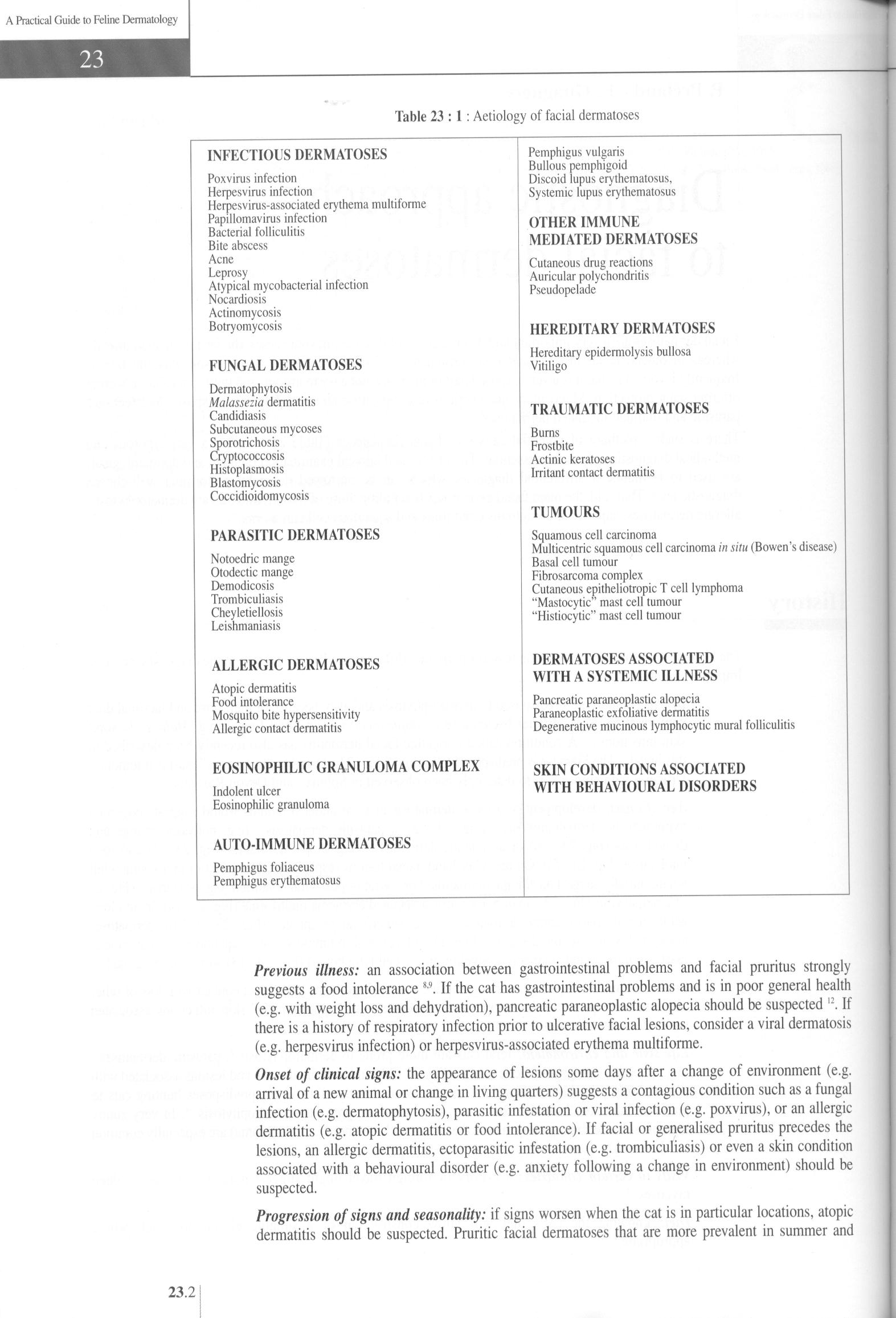232 (24)

23
A Practical Guide to Feline Dermatology
Table 23 : 1 : Aetiology of facial dermatoses
INFECTIOUS DERMATOSES
Poxvirus infection Herpesvirus infection
Herpesvirus-associated erythema multiforme
Papillomavirus infection
Bacterial folliculitis
Bite abscess
Acne
Leprosy
Atypical mycobacterial infection
Nocardiosis
Actinomycosis
Botryomycosis
FUNGAL DERMATOSES
Dermatophytosis
Malassezia dermatitis
Candidiasis
Subcutaneous mycoses
Sporotrichosis
Cryptococcosis
Histoplasmosis
Blastomycosis
Coccidioidomycosis
PARASITIC DERMATOSES
Notoedric mange
Otodectic mange
Demodicosis
Trombiculiasis
Cheyletiellosis
Leishmaniasis
ALLERGIC DERMATOSES
Atopic dermatitis Food intolerance Mosąuito bite hypersensitivity Allergic contact dermatitis
Pemphigus vulgaris Bullous pemphigoid Discoid lupus erythematosus, Systemie lupus erythematosus
OTHER IMMUNE MEDIATED DERMATOSES
Cutaneous drug reactions Auricular polychondritis Pseudopelade
TUMOURS
Squamous celi carcinoma
Multicentric sąuamous celi carcinoma in situ (Bowen’s disease)
Basal celi tumour
Fibrosarcoma complex
Cutaneous epitheliotropic T celi lymphoma
“Mastocytic” mast celi tumour
“Histiocytic” mast celi tumour
DERMATOSES ASSOCIATED WITH A SYSTEMIC ILLNESS
Pancreatic paraneoplastic alopecia Paraneoplastic exfoliative dermatitis Degenerative mucinous lymphocytic mural folliculitis
Preńous illness: an association between gastrointestinal problems and facial pruritus strongly suggests a food intolerance 89. If the cat has gastrointestinal problems and is in poor generał health (e.g. with weight loss and dehydration), pancreatic paraneoplastic alopecia should be suspected l2. If there is a history of respiratory infection prior to ulcerative facial lesions, consider a viral dermatosis (e.g. herpesvirus infection) or herpesvirus-associated erythema multiforme.
Onset of clinical signs: the appearance of lesions some days after a change of environment (e.g. arrival of a new animal or change in living quarters) suggests a contagious condition such as a fungal infection (e.g. dermatophytosis), parasitic infestation or viral infection (e.g. poxvirus), or an allergic dermatitis (e.g. atopic dermatitis or food intolerance). If facial or generalised pruritus precedes the lesions, an allergic dermatitis, ectoparasitic infestation (e.g. trombiculiasis) or even a skin condition associated with a behavioural disorder (e.g. anxiety following a change in environment) should be suspected.
Progression of signs and seasonality: if signs worsen when the cat is in particular locations, atopic dermatitis should be suspected. Pruritic facial dermatoses that are morę prevalent in summer and
Wyszukiwarka
Podobne podstrony:
234 (22) 23 A Practical Guide to Feline Dermatology autumn, point towards parasitic dermatoses7 such
248 (22) 24 A Practical Guide to Feline DermatologyDiagnostic tests Given the incidence of dermatoph
58 (148) 5 A Practical Guide to Feline Dermatology severity of the illness. High titres are seen wit
65 (127) 6 A Practical Guide to Feline Dermatology Other topical antimicrobial agents, such as chlor
67 (125) 6 A Practical Guide to Feline DermatologyNocardiosisAetiopathogenesis Nocardiosis is a very
69 (119) 6 A Practical Guide to Feline DermatologyDiagnosis The diagnosis is based on lesion distrib
710 (2) 7 A Practical Guide to Feline DermatologyHerpesvirus infections Dermatological manifestation
74 (105) 7 A Practical Guide to Feline Dermatology ulcerated. Lesion distribution is multicentric bu
27 A Practical Guide to Feline Dermatology Perianal glands 1.7 Permethrin 3.12, 3.13 Persian 1.6,2.2
27 A Practical Guide to Feline Dermatology Stemphyllium spp. 5.1,7.8 Stereotypie behaviour 17.1,
272 (16) 27 A Practical Guide to Feline Dermatology Alternaria spp. 5.1,7.8 Aluminium hyroxide 15.6&
274 (18) 27 A Practical Guide to Feline Dermatology Colitis 11.2 Collagen 1.2,2.6,12.1,
278 (17) 27 A Practical Guide to Feline Dermatology I J Histoplasmosis 5.8, 7.8, 25.2 Homer’s syndro
28 (374) 2 A Practical Guide to Feline Dermatology Configuration of lesions Determining the configur
313 (14) A Practical Guide to Feline Dermatology The second phase consists of long-term control of t
31 (328) 3 A Practical Guide to Feline Dermatology Sarcoptic mange Sarcoptes scabiei var canis (Tabl
82 (128) 8 A Practical Guide to Feline Dermatology considered important parasites. Cats in the Unite
42 (226) 4 A Practical Guide to Feline Dermatology Increased hydration and subsequent maceration of
44 (228) 4 A Practical Guide to Feline Dermatolog) The term “asymptomatically infected cat” refers
więcej podobnych podstron